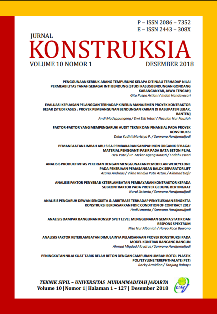PEMANFAATAN LIMBAH ABU SISA PEMBAKARAN SAMPAH NON ORGANIK SEBAGAI MATERIAL PENGGANTI PASIR PADA BATA BETON PEJAL
DOI:
https://doi.org/10.24853/jk.10.1.39-50Abstract
Abstrak : Meningkatnya pembangunan rumah dan konstruksi gedung mengakibatkan naiknya pemesanan akan bata beton pejal sehingga kebutuhan bahan dasar dari bata beton pejal seperti pasir juga meningkat. Kebutuhan pasir yang meningkat akan menaikkan harga pasir, terutama untuk daerah yang sulit mendapatkan pasir. Bahan alternatif pengganti pasir adalah dengan memanfaatkan limbah abu sisa pembakaran sampah non organik. Limbah abu sisa pembakaran sampah non organik dipilih karena memiliki ukuran yang hampir sama dengan pasir dan salah satu upaya untuk mengurangi masalah lingkungan. Penelitian dilakukan secara eksperimental dengan dua tahap pengujian. Pada tahap awal penelitian dilakukan pengujian pendahuluan yang meliputi pengujian sifat fisik bahan. Tahap kedua dilakukan pembuatan benda uji dengan variasi campuran limbah abu sisa pembakaran sampah 0%, 10%, 20%, 30%, 40% dan 50% dari jumlah pasir, kemudian dilakukan pengujian tekan pada umur 7, 14, 21 dan 28 hari. Dari hasil pengujian didapatkan nilai kuat tekan optimum terdapat pada variasi 10% limbah abu sisa pembakaran sampah sebesar 51,24 kg/cm2 dan termasuk kedalam tingkat Mutu III dengan penyerapan air sebesar 9,40%. Nilai kuat tekan terendah terdapat pada variasi campuran 50% limbah abu sisa pembakaran sampah sebesar 19,37 kg/cm2 tidak termasuk pada tingkat mutu dengan serapan air sebesar 16,22%. Berdasarkan hasil pengujian diketahui bahwa limbah abu sisa pembakaran sampah dapat digunakan sebagai substitusi pasir pada bata beton pejal dan masih termasuk ke dalam tingkat mutu III dan IV menurut SNI 03-0349-1989 sehingga dapat digunakan sebagai alternatif bahan konstruksi pengganti bata. Kata Kunci : Bata beton pejal, limbah, sampah non organik, kuat tekan, ramah lingkungan Abstract : The increasing of house construction and building construction effected an increasing of solid concrete brick demands so, it caused the basic material requirement of solid concrete brick such as sand is also increased. The increase of sand demands will increase the sand price, especially for areas which are rare of sand production. The alternative materials to substitute sand are by utilizing ash waste left over from non-organic waste combustion. Waste of residual ash from non-organic waste combustion is chosen because its same size with sand and one of the efforts to reduce environmental problems. The study was conducted experimentally with two stages of testing. At the initial stage of the research preliminary testing is carried out which includes testing the physical properties of the material. The second stage was made by making specimens with a variation of the residual ash waste mixture combustion 0%, 10%, 20%, 30%, 40% and 50% of the amount of sand, then press testing conducted at the age of 7, 14, 21 and 28 days. From the test results obtained the value of the optimum compressive strength is in the variation of 10% waste residual waste combustion as much as 51.24 kg /cm2 and get the Third Quality level with 9.40% water absorption. The lowest compressive strength value is in the mixture variation of 50% residual ash waste combustion of 19.37 kg / cm2 not included in the quality level with 16.22% water uptake. Based on the results of the test is that the residual ash waste can be used as a substitute for sand in solid concrete bricks and is still get the Third and Fourth Quality according to SNI 03-0349-1989 so, it can be used as an alternative to brick replacement construction materials. Keywords : solid concrete brick, waste, non-organic waste, compressive strength, environmentally friendlyDownloads
Published
2019-10-04
Issue
Section
Articles

